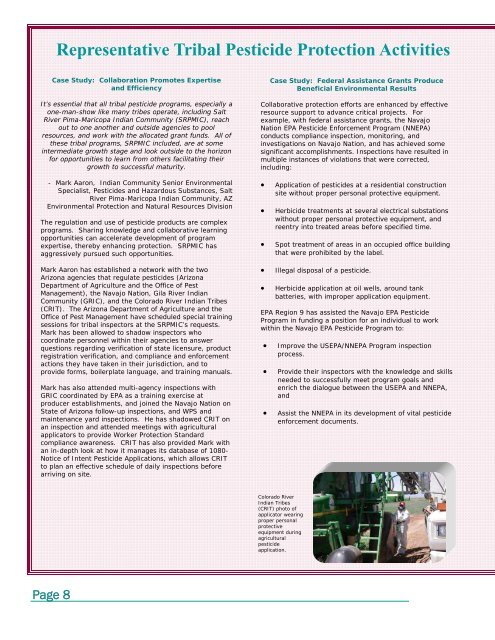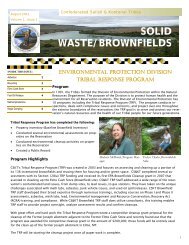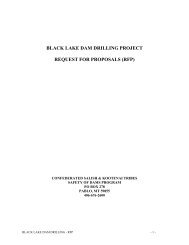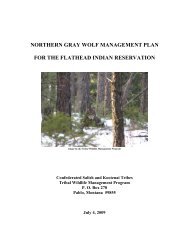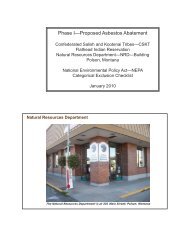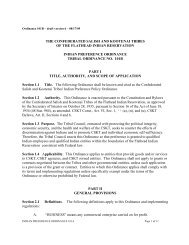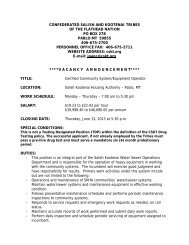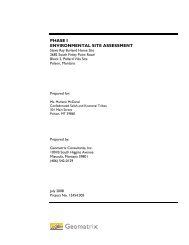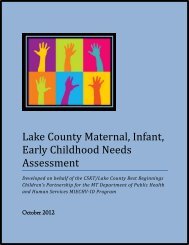US EPA - The National Pesticide Tribal Program - US Environmental ...
US EPA - The National Pesticide Tribal Program - US Environmental ...
US EPA - The National Pesticide Tribal Program - US Environmental ...
Create successful ePaper yourself
Turn your PDF publications into a flip-book with our unique Google optimized e-Paper software.
Representative <strong>Tribal</strong> <strong>Pesticide</strong> Protection Activities <br />
Case Study: Collaboration Promotes Expertise<br />
and Efficiency<br />
It’s essential that all tribal pesticide programs, especially a<br />
one-man-show like many tribes operate, including Salt<br />
River Pima-Maricopa Indian Community (SRPMIC), reach<br />
out to one another and outside agencies to pool<br />
resources, and work with the allocated grant funds. All of<br />
these tribal programs, SRPMIC included, are at some<br />
intermediate growth stage and look outside to the horizon<br />
for opportunities to learn from others facilitating their<br />
growth to successful maturity.<br />
- Mark Aaron, Indian Community Senior <strong>Environmental</strong><br />
Specialist, <strong>Pesticide</strong>s and Hazardous Substances, Salt<br />
River Pima-Maricopa Indian Community, AZ<br />
<strong>Environmental</strong> Protection and Natural Resources Division<br />
<strong>The</strong> regulation and use of pesticide products are complex<br />
programs. Sharing knowledge and collaborative learning<br />
opportunities can accelerate development of program<br />
expertise, thereby enhancing protection. SRPMIC has<br />
aggressively pursued such opportunities.<br />
Mark Aaron has established a network with the two<br />
Arizona agencies that regulate pesticides (Arizona<br />
Department of Agriculture and the Office of Pest<br />
Management), the Navajo Nation, Gila River Indian<br />
Community (GRIC), and the Colorado River Indian Tribes<br />
(CRIT). <strong>The</strong> Arizona Department of Agriculture and the<br />
Office of Pest Management have scheduled special training<br />
sessions for tribal inspectors at the SRPMIC’s requests.<br />
Mark has been allowed to shadow inspectors who<br />
coordinate personnel within their agencies to answer<br />
questions regarding verification of state licensure, product<br />
registration verification, and compliance and enforcement<br />
actions they have taken in their jurisdiction, and to<br />
provide forms, boilerplate language, and training manuals.<br />
Mark has also attended multi-agency inspections with<br />
GRIC coordinated by <strong>EPA</strong> as a training exercise at<br />
producer establishments, and joined the Navajo Nation on<br />
State of Arizona follow-up inspections, and WPS and<br />
maintenance yard inspections. He has shadowed CRIT on<br />
an inspection and attended meetings with agricultural<br />
applicators to provide Worker Protection Standard<br />
compliance awareness. CRIT has also provided Mark with<br />
an in-depth look at how it manages its database of 1080-<br />
Notice of Intent <strong>Pesticide</strong> Applications, which allows CRIT<br />
to plan an effective schedule of daily inspections before<br />
arriving on site.<br />
Case Study: Federal Assistance Grants Produce<br />
Beneficial <strong>Environmental</strong> Results<br />
Collaborative protection efforts are enhanced by effective<br />
resource support to advance critical projects. For<br />
example, with federal assistance grants, the Navajo<br />
Nation <strong>EPA</strong> <strong>Pesticide</strong> Enforcement <strong>Program</strong> (NN<strong>EPA</strong>)<br />
conducts compliance inspection, monitoring, and<br />
investigations on Navajo Nation, and has achieved some<br />
significant accomplishments. Inspections have resulted in<br />
multiple instances of violations that were corrected,<br />
including:<br />
• Application of pesticides at a residential construction<br />
site without proper personal protective equipment.<br />
• Herbicide treatments at several electrical substations<br />
without proper personal protective equipment, and<br />
reentry into treated areas before specified time.<br />
• Spot treatment of areas in an occupied office building<br />
that were prohibited by the label.<br />
• Illegal disposal of a pesticide.<br />
• Herbicide application at oil wells, around tank<br />
batteries, with improper application equipment.<br />
<strong>EPA</strong> Region 9 has assisted the Navajo <strong>EPA</strong> <strong>Pesticide</strong> <br />
<strong>Program</strong> in funding a position for an individual to work <br />
within the Navajo <strong>EPA</strong> <strong>Pesticide</strong> <strong>Program</strong> to:<br />
• Improve the <strong>US</strong><strong>EPA</strong>/NN<strong>EPA</strong> <strong>Program</strong> inspection <br />
process. <br />
• Provide their inspectors with the knowledge and skills<br />
needed to successfully meet program goals and<br />
enrich the dialogue between the <strong>US</strong><strong>EPA</strong> and NN<strong>EPA</strong>,<br />
and<br />
• Assist the NN<strong>EPA</strong> in its development of vital pesticide<br />
enforcement documents.<br />
Colorado River<br />
Indian Tribes<br />
(CRIT) photo of<br />
applicator wearing<br />
proper personal<br />
protective<br />
equipment during<br />
agricultural<br />
pesticide<br />
application.<br />
Page 8


